Applying the ICAT Sustainable Development Methodology to Assess the Impacts of Promoting a Greater Sustainability of the Charcoal Value Chain in Mozambique
Abstract
:1. Introduction
- Identify other impact categories of the NAMA Charcoal and establish how to mitigate negative impacts while strengthening positive ones;
- Conduct an ex-ante assessment of policy Charcoal NAMA, including the development of a baseline, policy scenarios, and estimation of sustainable development impacts;
- Identify barriers and gaps in monitoring and reporting of indicators and parameters for the policy NAMA Charcoal and identify ways to overcome these barriers to enhance the transparency of the framework at the national level.
2. Background
3. Materials and Methods
3.1. Methodological Approach
- Briquetting charcoal residues: The current production process leaves a significant volume of small pieces and charcoal dust in the field. A rough estimate would suggest a loss of 200 kg material per kiln production, which can be used for briquette.
- Modern kilns and sustainable forest management: Efficient and modern kilns allow for more efficient charcoal production: a brick kiln has a 3:1 (wood/charcoal) ratio instead of 7:1 by the current earth kilns. Producers experience forest degradation as a limitation to their production, and the introduction of efficient kilns should, therefore, be combined with sustainable forest management (SFM).
- Torrefaction by the private sector: torrefaction can be a commercially viable option in regions with (a) a high level of charcoal production with producers that already produce the maximum amount allowed by their licenses, and (b) lower levels of organizational capacity and thus fewer opportunities for the above-mentioned projects.
3.2. Identification and Selection of Impact Categories of the NAMA Charcoal
3.3. Impact Assessment of Charcoal NAMA and Scenario Narratives
3.4. Activity Data for Baseline Scenario Development
3.5. Estimation of a Baseline of Emission Reduction Potential of Identified Mitigation Technologies in the Charcoal NAMA
3.6. Evaluate and Validate the Impact Categories and Scenarios
4. Results
4.1. Qualitative Assessment of the Identified Impact of Charcoal NAMA
4.2. Quantitative Assessment of Emission Reductions of the Charcoal NAMA
4.2.1. Introducing Modern Kilns and Sustainable Forest Management
4.2.2. Briquetting Charcoal Waste Materials
4.2.3. Torrefaction
4.2.4. Greenhouse Gas Emission from Charcoal Transportation
4.2.5. Cumulative Emission Reduction Scenario of all Selected NAMA’s Technologies
4.3. Quantitative Assessment of Social and Economic Impact Categories of the Charcoal NAMA
4.4. Validation of the Impact
5. Discussion
5.1. Potential of Charcoal NAMA for Greenhouse Gas Emission Reduction
5.2. Insights for Robust and Transparent Emission Estimates for the Charcoal Sector
6. Conclusions
7. Limitations
Supplementary Materials
Author Contributions
Funding
Acknowledgments
Conflicts of Interest
References
- UNFCCC. Paris Agreement. 2015. Available online: http:Unfccc.int/files/meetings/paris_nov_2015/application/pdf/paris_agreement_english_.pdf (accessed on 19 August 2020).
- Falcão, M.P. Charcoal Production and Use in Mozambique, Malawi, Tanzania, and Zambia: Historical Overview, Present Situation, and Outlook; UEM: Mpauto, Mozambique, 2008. [Google Scholar]
- INE. IV Recenseamento Geral da População e Habitação 2017; Resultados Definitivos: Mpauto, Mozambique, 2019. [Google Scholar]
- Falcão, M.; Sumaila, R.; Grundy, I.; Geldenhuys, C. The impact of policy on resource use in Mozambique: A case study of Savane. Silva Lusit. 2007, 15, 89–102. [Google Scholar]
- Brouwer, R.; Falcão, M.P. Wood fuel consumption in Maputo, Mozambique. Biomass Bioenergy 2014, 27, 233–245. [Google Scholar] [CrossRef]
- Sedano, F.; Silva, J.A.; Machoco, R.; Meque, C.H.; Sitoe, A.; Ribeiro, N.; Anderson, K.; Ombe, Z.A.; Baule, S.H.; Tucker, C.J. The impact of charcoal production on forest degradation: A case study in Tete, Mozambique. Environ. Res. Lett. 2016, 11. [Google Scholar] [CrossRef] [PubMed]
- Sedano, F.; Lisboa, S.N.; Duncanson, L.; Ribeiro, N.; Sitoe, A.; Sahajpal, R.; Hurtt, G.; Tucker, C.J. Monitoring forest degradation from charcoal production with historical Landsat imagery. A case study in southern Mozambique. Environ. Res. Lett. 2020, 15. [Google Scholar] [CrossRef]
- Baumert, S.; Luz, A.C.; Fisher, J.; Vollmer, F.; Ryan, C.M.; Patenaude, G.; Zorrilla-Miras, P.; Artur, L.; Nhantumbo, I.; Macqueen, D. Energy for Sustainable Development Charcoal supply chains from Mabalane to Maputo: Who benefits? Energy Sustain. Dev. 2016, 33, 129–138. [Google Scholar] [CrossRef] [Green Version]
- Zorrilla-Miras, P.; Mahamane, M.; Metzger, M.J.; Baumert, S.; Vollmer, F.; Luz, A.C.; Woollen, E.; Sitoe, A.A.; Patenaude, G.; Nhantumbo, I.; et al. Environmental Conservation and Social Benefits of Charcoal Production in Mozambique. Ecol. Econ. 2018, 144, 100–111. [Google Scholar] [CrossRef]
- Government of Mozambique. Mozambique Biomass Strategy; Ministry of Energy: Maputo, Mozambique, 2012.
- De Koning, P.C.; Atanassov, B.; Heidemann, F.; Jorritsma, M. Sustainable Charcoal Value Chain Mozambique: Feasibility Study on climate financing for a Sustainable Charcoal Production Chain. Energy Eng. Solut. 2014. Available online: https://www.google.com.hk/url?sa=t&rct=j&q=&esrc=s&source=web&cd=&ved=2ahUKEwiCreXDitbsAhWSGKYKHeliDZYQFjAAegQIAxAC&url=http%3A%2F%2Fgreenlight-africa.com%2Fassets%2Fees_international_(2014)_feasibility_study_charcoal_mozambique_final_with_translation.pdf&usg=AOvVaw1Ps7hsetZh76GjwvErAgwi (accessed on 28 May 2020).
- United Nations General Assembly. Transforming Our World: The 2030 Agenda for Sustainable Development; Division for Sustainable Development Goals: New York, NY, USA, 2015; Available online: https://sustainabledevelopment.un.org/post2015/transformingourworld/publication (accessed on 19 August 2020).
- Sedano, F.; Lisboa, S.N.; Duncanson, L.; Ribeiro, N.; Sitoe, A.; Sahajpal, R.; Hurtt, G.; Tucker, C.J. Monitoring intra and inter annual dynamics of forest degradation from charcoal production in Southern Africa with Sentinel—2 imagery. Int. J. Appl. Earth Obs. Geoinf. 2020, 92, 102184. [Google Scholar] [CrossRef]
- ICAT (Initiative for Climate Action Transparency). Sustainable Development Methodology: Assessing the Environmental, Social and Economic Impacts of Policies and Actions; Copenhagen: UNEP DTU Partnership; Rich, D., Song, R., Olsen, K.H., Eds.; World Resources Institute: Washington, DC, USA, 2020; Available online: https://climateactiontransparency.org/icat-toolbox/sustainable-development (accessed on 10 May 2020).
- Electricidade de Mocambique, E.P. EDM Strategy 2018–2028; Electricidade de Mocambique: Maputo, Mozambique, 2018. [Google Scholar]
- Government of Mozambique. Estrategia de Desenvolvimento de Energias novas e renovaveis (EDENR) 2011–2025; Ministerio de Energia: Maputo, Mozambique, 2011.
- DINAF. Relatórios de Balanco Annual de Terras, Florestas e Fauna Bravia—2017; DINAF: Maputo, Mozambique, 2017.
- Government of Mozambique. Plano Estrategico de Educacao 2012–2016; MINED: Maputo, Mozambique, 2012.
- Pereira, C.; Brouwer, R.; Monjane, M.; Falcão, M.P. Final report for Mozambique. In Charcoal Potential in Southern Africa; Ellegård, A., Ed.; Stockholm Environment Institute: Stockholm, Sweden, 2001. [Google Scholar]
- Alberto, M.M. A Contribution of the Forestry and Wildlife Sector to the Country’s Economy; National Directorate of Forestry and Wildlife: Maputo, Mozambique, 2006.
- Nhancale, B.A.; Mananze, S.E.; Dista, N.F.; Nhantumbo, I.; Macqueen, D.J. Small and Medium Forest Enterprises in Mozambique; IIED Small and Medium Forest Enterprise Series No. 25; Centro Terra Viva and International Institute for Environment and Development: London, UK, 2009. [Google Scholar]
- Government of Mozambique. Mozambique’s Forest Reference Emission Level for Reducing Emissions from Deforestation in Natural Forests; Government of Mozambique: Maputo, Mozambique, 2018.
- UNFCCC CDM AMS-III.BG. Emission Reduction through Sustainable Charcoal Production and Consumption. Available online: https://cdm.unfccc.int/methodologies/DB/MVOAXD3LGD4ZJEKEERCT39ZLJ3JZA0 (accessed on 15 April 2019).
- UNFCCC CDM AMS-III-K. Avoidance of Methane Release from Charcoal Production. Available online: https://cdm.unfccc.int/methodologies/DB/5RNUZSHHSABLSU97RQSDFB2D433ECB/view.html (accessed on 15 April 2019).
- UNFCCC CDM ACM0021. Reduction of Emissions from Charcoal Production by Improved Kiln Design and/or Abatement of Methane EB67_repan08_ACM0021_NM0341. Available online: https://cdm.unfccc.int/methodologies/DB/AA1T5PNLA4SMCJA2OQK9XRTC08BA6J (accessed on 15 April 2019).
- IPCC. 2006 IPCC Guidelines for National Greenhouse Gas Inventories; Prepared by the National Greenhouse Gas Inventories, Programme; Eggleston, H.S., Buendia, L., Miwa, K., Ngara, T., Tanabe, K., Eds.; Institute for Global Environmental Strategies: Kanagawa, Japan, 2006. [Google Scholar]
- Mate, R.; Johansson, T.; Sitoe, A. Biomass Equations for Tropical Forest Tree Species in Mozambique. Forests 2014, 5, 535–556. [Google Scholar] [CrossRef] [Green Version]
- Mate, R.; Johansson, T.; Sitoe, A. Stem Volume Equations for Valuable Timber Species in Mozambique. J. Sustain. For. 2015, 34, 787–806. [Google Scholar] [CrossRef]
- Kalaba, F.K.; Quinn, C.H.; Dougill, A.J.; Vinya, R. Floristic composition, species diversity and carbon storage in charcoal and agriculture fallows and management implications in Miombo woodlands of Zambia. For. Ecol. Manag. 2013, 304, 99–109. [Google Scholar] [CrossRef] [Green Version]
- FAO. The Charcoal Transition: Greening the Charcoal Value Chain to Mitigate Climate Change and Improve Local Livelihoods; Food and Agriculture Organization of the United Nations: Rome, Italy, 2017. [Google Scholar]
- Brown, S.; Sathaye, J.A.; Cannell, M.; Kauppi, P. Management actions: Mitigation of carbon emissions to the atmosphere by forest management. Commonw. For. Rev. 1996, 75, 80–91. [Google Scholar]
- Mwampamba, T.H. Has the woodfuel crisis returned? Urban charcoal consumption in Tanzania and its implications to present and future forest availability. Energy Policy 2007, 35, 4221–4234. [Google Scholar] [CrossRef]
- Chidumayo, E.N.; Gumbo, D.J. The environmental impacts of charcoal production in tropical ecosystems of the world: A synthesis. Energy Sustain. Dev. 2013, 17, 86–94. [Google Scholar] [CrossRef]
- Government of Mozambique. Plano de operacionalização da NDC; Versão Resumo; MITADER: Maputo, Mozambique, 2018.
- Cucchiella, F.; D’Adamo, I.; Gastaldi, M.; Koh, S.C.L.; Santibanez-Gonzalez, E.D.R. Assessment of GHG emission in Europe: Future estimates and policy implications. Environ. Eng. Manag. J. 2020, 19, 131–142. [Google Scholar]
- Batidzirai, B.; Faaij, A.P.; Smeets, E. Biomass and bioenergy supply from Mozambique. Energy Sustain. Dev. 2006, 10, 54–81. [Google Scholar] [CrossRef] [Green Version]
- Mate, R. Potentials and Wood Fuel Quality of Logging Residues from Indigenous and Planted Forests in Mozambique. Ph.D. Thesis, Swedish University of Agricultural Sciences, Uppsala, Sweden, 2016. [Google Scholar]
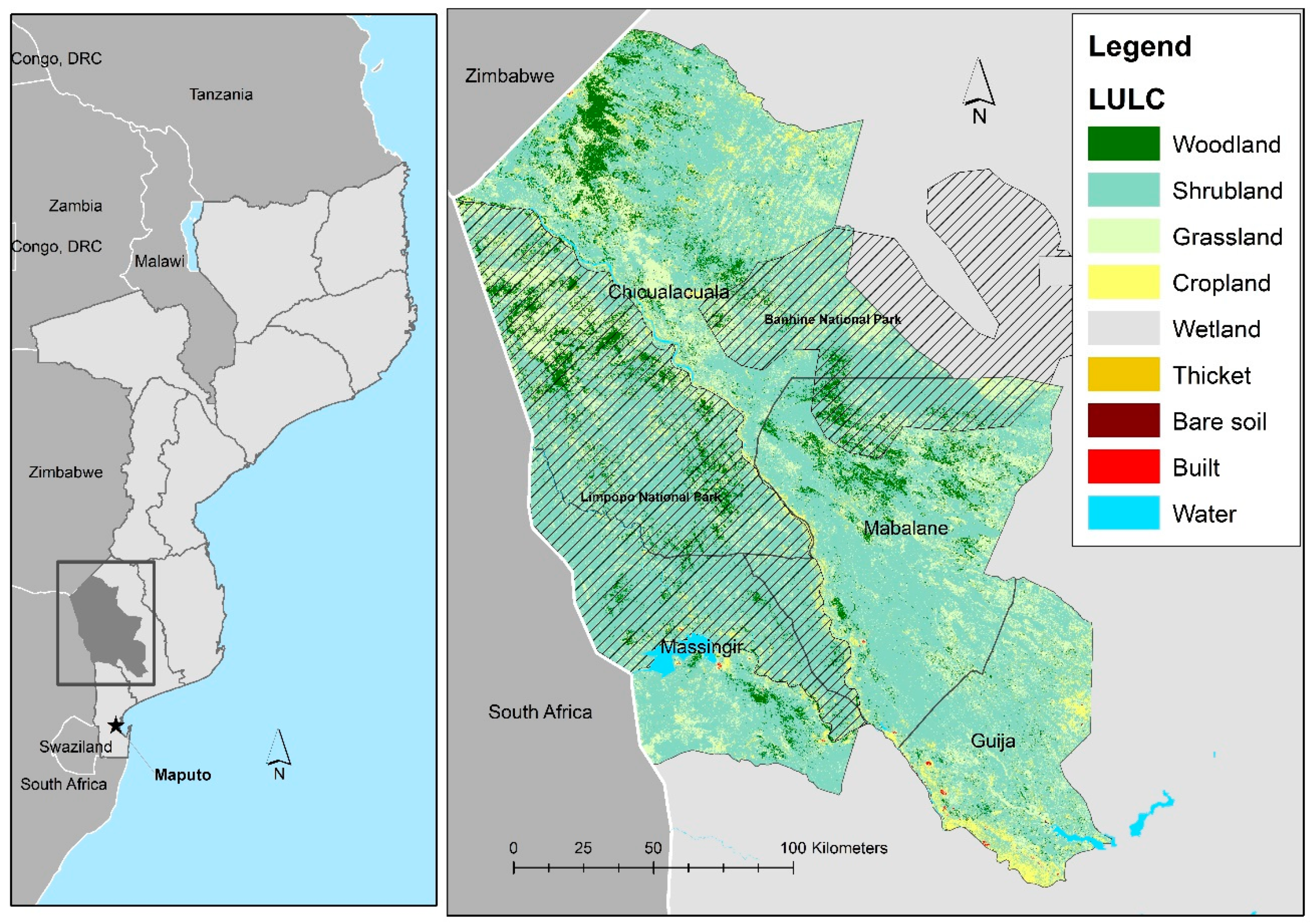
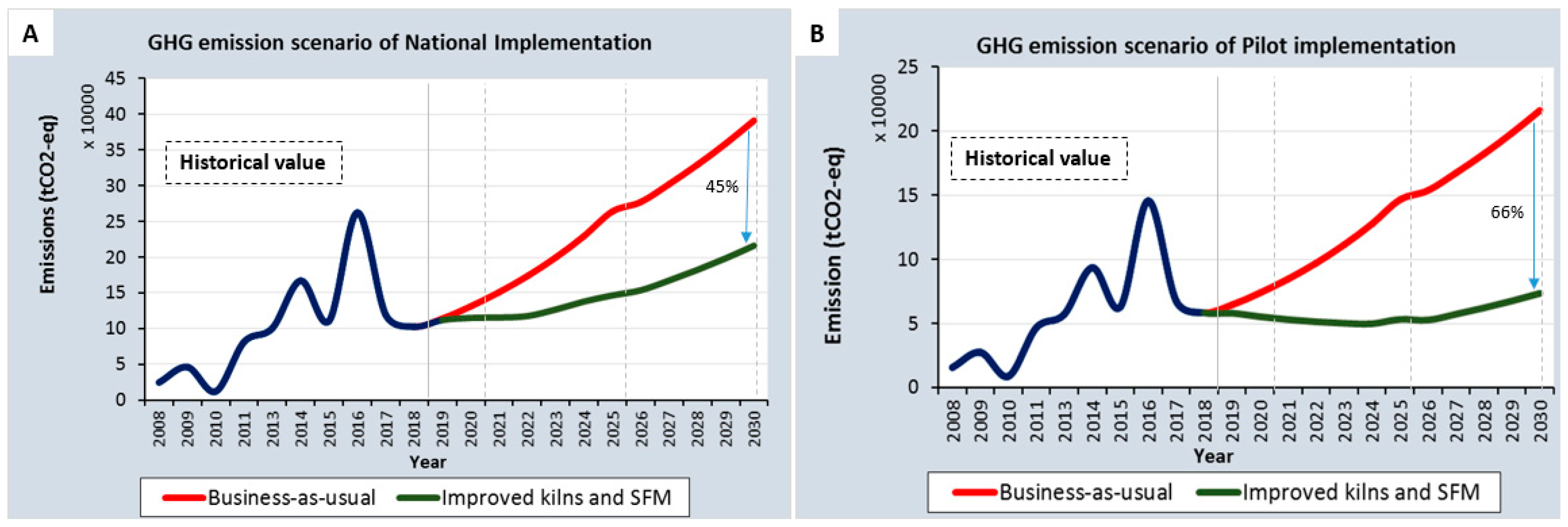
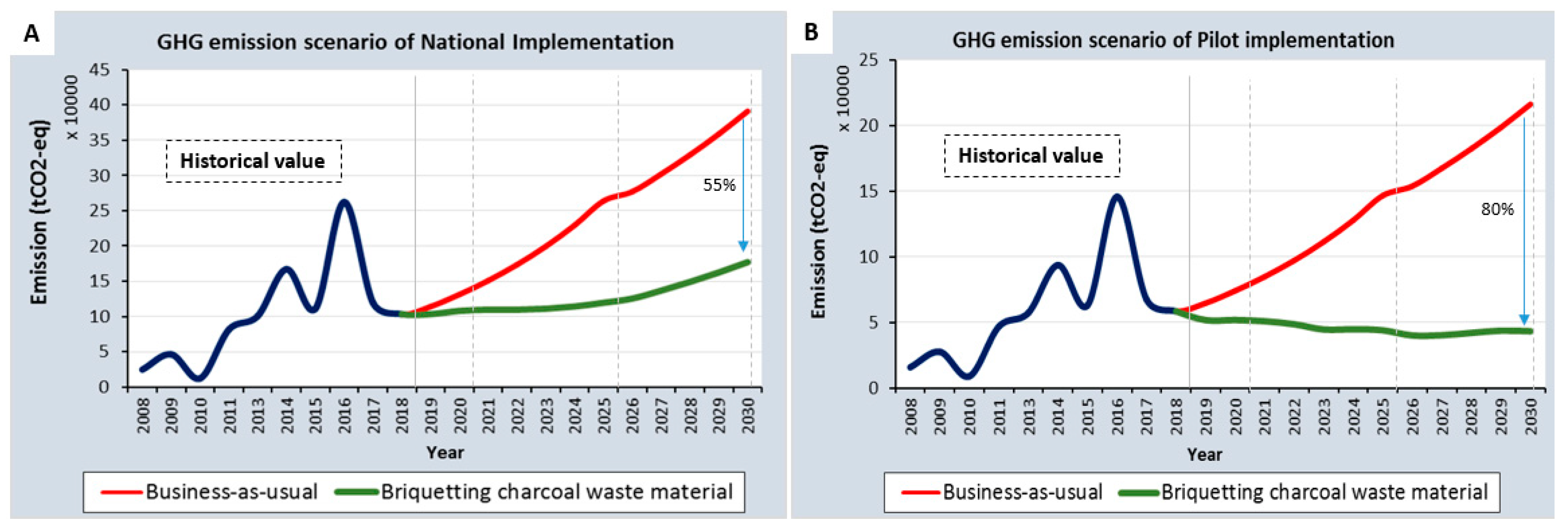
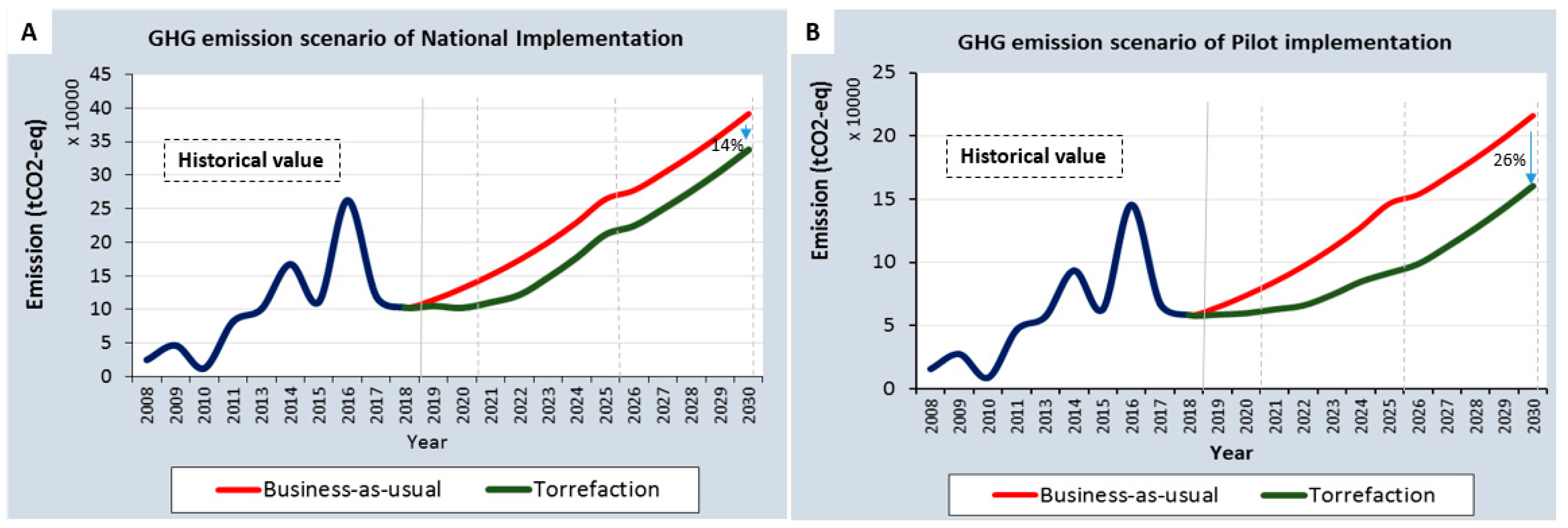
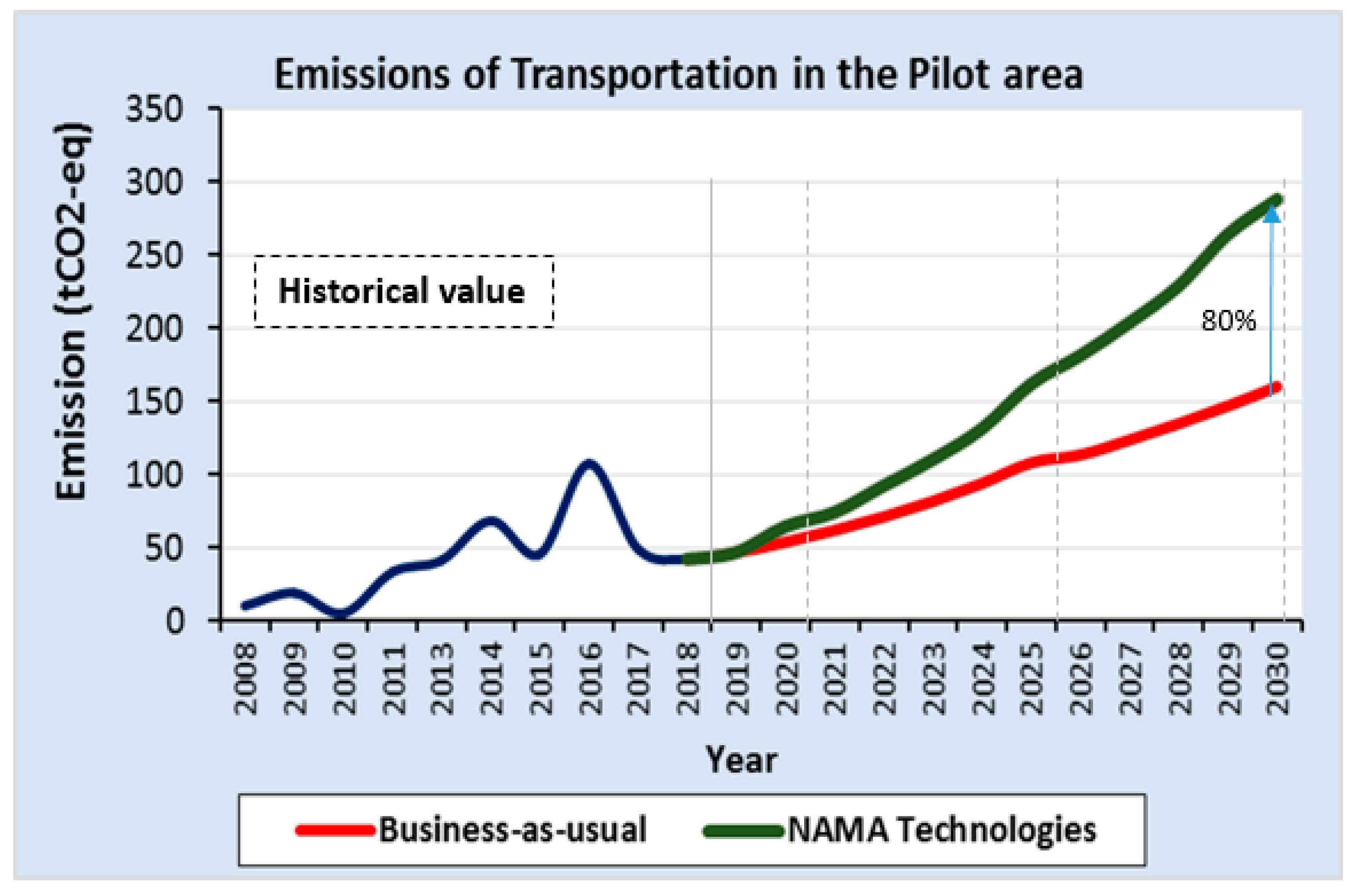

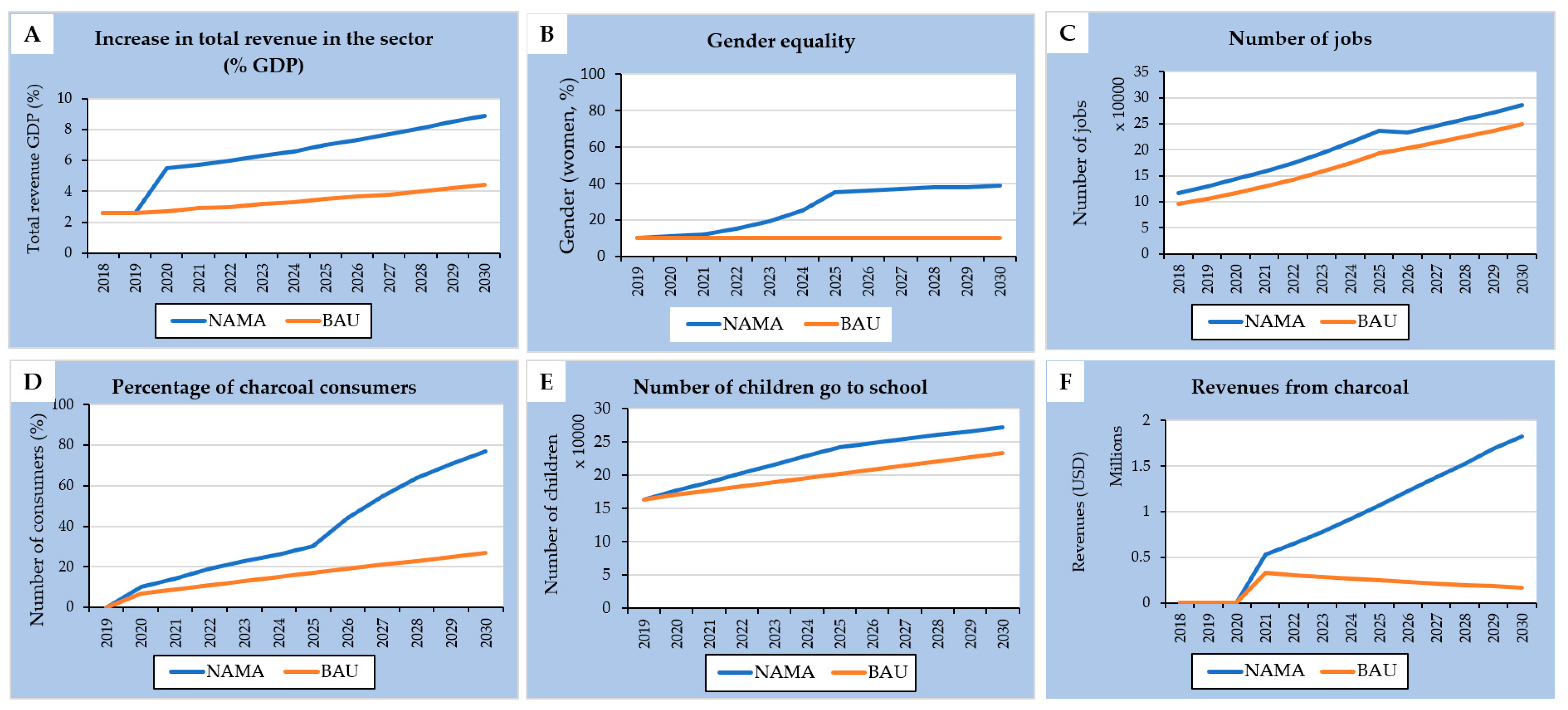
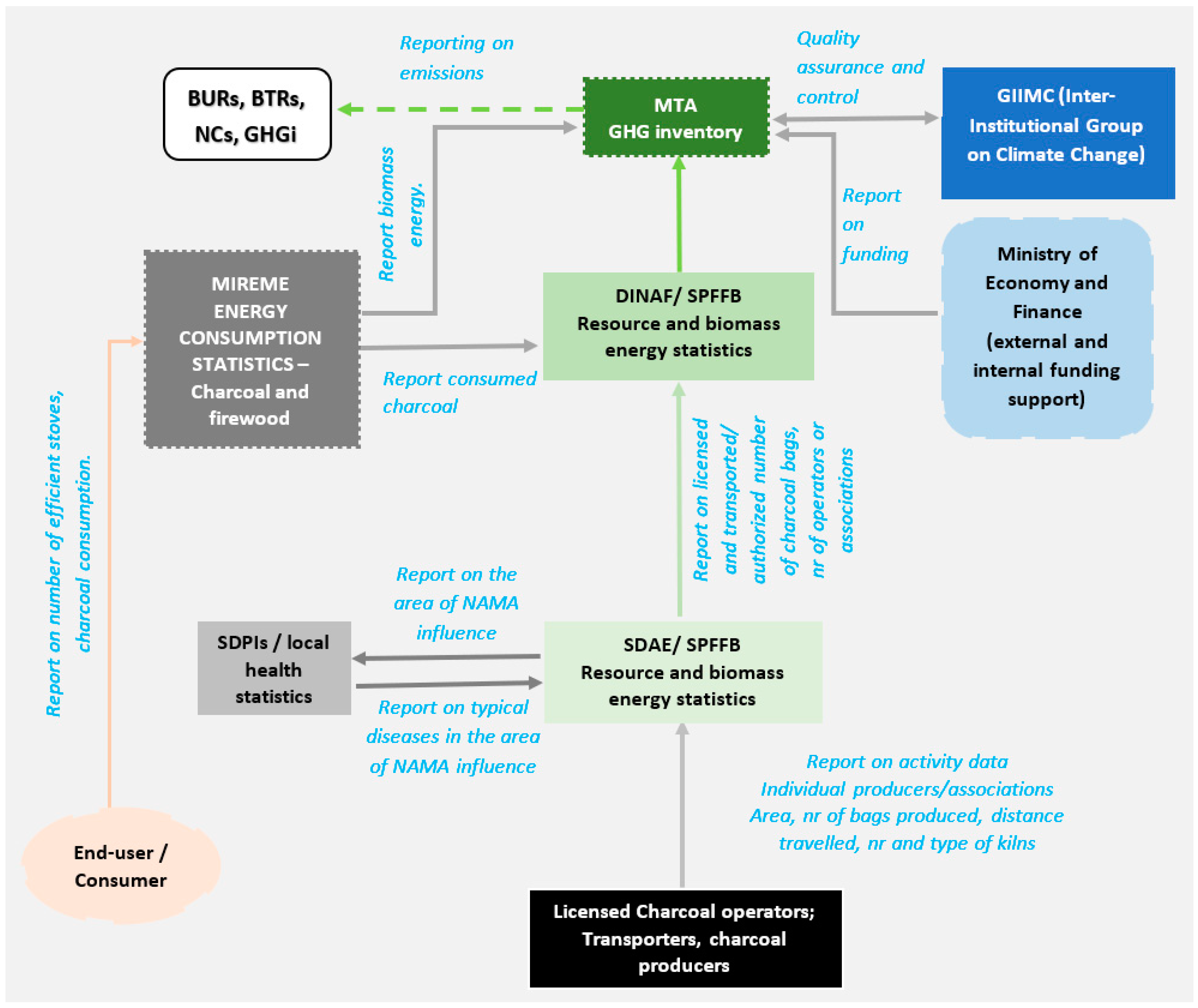
| The Technology Selected from Charcoal NAMA | Business-As-Usual Scenario | Mitigation Scenarios | |
|---|---|---|---|
| Pilot Implementation of Charcoal NAMA | National Implementation of Charcoal NAMA | ||
| Introduce efficient kilns and sustainable forest management | -Charcoal producers will keep using traditional kilns | -Introduce 200 improved kilns, with a gradual increase over time; (Casamance kiln with 20–30% of average conversion and 30% of efficiency) | -More than 50% of producers will start using improved kilns; (All kiln technology will be introduced throughout the country. The average efficiency considered for all technology is 40%, with average conversion 3:1) |
| -The area where charcoal production happened has some mopane regeneration and coppicing (resprouting) | -Trees are cut selectively for charcoal production; | -Awareness of environmental issues will be provided to the charcoal association throughout the country. | |
| -More than 40% of charcoal producer use improved kilns; | -The charcoal producer will be trained in sustainable forest management implementation. | ||
| -There is no forest management | -Coppice management will happen with no interruption; | -Less CO2 will be emitted because of the prevention of deforestation; | |
| -Both large scale producers and small-scale producers use the same area of charcoal production | -Small scale producer do not overlap with large scale producer at all; | -Any national or regional forestry and nature conservation regulations are complied with. | |
| -The SFM focuses on the regrow of native species, reducing forest degradation, and increase removals source. | |||
| Briquetting charcoal waste materials | -Charcoal is produced using traditional kilns with low efficiency, and 100% of the charcoal waste powder and small fragments remain non-utilized | -Fewer trees will be logged, and CO2 will be emitted while producing the same amount of charcoal; | -Fewer trees will be logged, and CO2 will be emitted, while producing the same amount of charcoal |
| -Briquetting will reduce in 25% of GHG emissions from charcoal production. | -Briquetting will reduce in 20% of GHG emission from charcoal production | ||
| Torrefaction by the private sector (forest plantation) | There is no and will be implemented any torrefaction project | -At least 10 ha of woodlot plantation will be established for torrefaction in the pilot area. The pilot area is semi-arid and needs drought-tolerant species. | -Woodlot plantation for torrefaction will increase by 30% throughout the country under the MozFIP project |
| Cumulative scenario (sum all technology) | We are considering all BAU assumptions. | -We are considering all pilot NAMA implementation assumptions. | -We are considering national NAMA implementation assumptions. |
| Impact Categories | Specific Impacts Identified | Indicator | Baseline (BAU)—National | Source | NAMA Scenario 2020–2030 |
|---|---|---|---|---|---|
| ENVIRONMENTAL DIMENSION | |||||
| Climate Change Mitigation | Quantified separately (see Table 1) | ||||
| The energy produced in a sustainable manner | Increase in complementary biomass and charcoal waste used, which will increase access to charcoal and other energy carriers (briquettes, torrefied material) produced in a sustainable way | Number of licensed charcoal producers engaged in charcoal efficiently produced and environmentally friendly | -4% of licensed operators -100% of charcoal produced unsustainably; | [12,15,16,17] | -The NAMA is expected to contribute to the increase of sustainable charcoal made by 2% per year. At least 20% of produced charcoal sustainable by 2025 |
| Number of charcoal consumers using sustainably produced charcoal | -28% population with access to clean energy (electricity, gas) -80% of urban and periurban areas are dependent on charcoal and wood for energy production. At least 60% can be assumed as a charcoal dependent population. | [2,5,15] | -An increase of 25% per year of people consuming sustainable charcoal in urban and peri-urban areas of the major cities Maputo, Matola, and (if National level, Nampula, Zambézia) is expected. | ||
| SOCIAL DIMENSION | |||||
| Education | Improved access to education for local children | Number of children enrolled in school | -Assumptions of the scenario provided by the Plano Estratégico de Educação (2012-2016) in which the entry (10%) and transition rates between different education levels are expected to be maintained. The rate of school dropouts (31.4%) and class repetition (28.2%). Transition between grades 7 to 8 (80%), 10 to 11 (60–70%). School entry and transition rates will be maintained between different levels of education. | [8,18] | -An increase in income will allow coverage of education expenses by charcoal stakeholders involved in the value chain. |
| Improved ability to produce charcoal sustainably by capacity, skills, and knowledge development | Number of workers in the charcoal value chain using more efficient and sustainable charcoal production technologies and forest management practices | Previous projects report that awareness campaigns for sustainable charcoal production have been conducted. However, no records are available. | [8,9,19] | The NAMA project includes awareness and training as activities. | |
| Gender equity | Increased gender equality promotion and women empowerment by created charcoal associations | % of women involved in activities in the charcoal value chain | The percentage of women in charcoal production at the national level historically does not exceed 10%. | Fieldwork estimates, De Koning et al. [11] | The charcoal producers’ organization in associations will allow integration of women and other groups in the value chain. NAMA has activities of forest management and stoves that might create opportunities. |
| ECONOMIC DIMENSION | |||||
| Labor | Increased number of employed people in the charcoal value chain (green jobs) | Number of people working in the sector | 87,000 people employed | [20,21] | Increased to 100,000 workers by 2025 and 150,000 by 2030 (average of 15 years) |
| Income | Local communities will receive 20% of the shared revenue of charcoal licensing. | Amount of revenues from charcoal’s licensing delivered to the community | The government accesses only about 4% of the sector’s revenue through charcoal licensing. | [21] | District Service for Economic Activities (SDAE) could increase its revenue by about 50.1 million Mt in 2025 and 100.7 million Mt by 2030, With 10.0 million MZN per year going to the communities in 2025 and 20.1 million MZN per year in 2030, as their 20% shares of license revenue. |
| Revenue | Increase in total revenue in the sector (% GDP) | % change in the forest sector revenue as a result of NAMA | Forest sector GDP varies between 4 to 11%, increased illegal logging and lack of recording limits the contribution | [20,21] | Improvement of registration and control of licensed charcoal and produced efficiently, is expected an increase in forest sector revenue by 5% a year, from the NAMA implementation |
| Impact Categories Included in the Assessment | Specific Impacts Identified | In- or out-of-Jurisdiction | Likelihood | Magnitude | Positive or Negative Impact | Significant | Summary of Qualitative Assessment Results for each Impact Category | Methods/Sources Used | Feasibility to Quantify | Included in the Quantitative Assessment Boundary? | Justification for Exclusions or other Comments | Impact Dimension | SDGs |
|---|---|---|---|---|---|---|---|---|---|---|---|---|---|
| Climate Change Mitigation | Reduction of GHG emission from the introduction of new technologies and practices | Both | Very likely | Moderate | Positive | Yes | The significant positive impact of charcoal production technology. While negative impacts do exist, they are insignificant | Stakeholder consultation, field studies, Clean Development Mechanism methodologies [23,24,25], and 2006 IPCC [26] | Yes | Yes | Included |   |    |
| Increased emissions from increase in transport need | Likely | Negative | No | Emission from transport, product distribution might be increased, however not significant | Field estimates and 2006 IPCC [26] | Yes | Yes | Included, but no reliable data | |||||
| Fire prevention | Reduction in the amount of accumulated residual biomass that may cause natural fires | Both | Very likely | Moderate | Positive | Yes | The major positive impact from the mobilization of charcoal waste and other biomass material that will allow the increase of raw material for charcoal production, which will reduce the need for forest clearing for energy production and prevention of forest fires | Stakeholder consultation; [27,28] | Yes | No | No reliable data |    |    |
| Water availability | Increased water available | Both | Likely | Moderate | Positive | Yes | Reduction of the silting effects on rivers and improved ecosystem services essential for water quality and availability | Stakeholder consultation and fieldwork interview | N/A | No | No reliable data |  |    |
| Water Quality | Increased amount of available water of adequate quality for domestic use, and irrigation | ||||||||||||
| Biodiversity of terrestrial ecosystems | Increased land areas managed in a sustainable way and reduction of disturbance of ecosystems | In | Very likely | Major | Positive | Yes | The major positive impact of charcoal production technology. While negative impacts do exist, they are insignificant | [29] and stakeholder consultation | No | No | No reliable data/methods available |  |   |
| Soil | Reduction of eroded areas | In | Very likely | Major | Positive | Yes | The major positive impact of charcoal production technology. While negative impacts do exist, they are insignificant | Stakeholder consultation | N/A | No | No reliable data/methods available |  |  |
| Increased soil fertility | |||||||||||||
| The energy produced in a sustainable manner | Increased access to charcoal and other energy carriers (briquettes, torrefied material) produced in a sustainable way | Out | Very likely | Major | Positive | Yes | The major positive impact from charcoal production technology. While negative impacts do exist, they are insignificant | Stakeholder consultation | Yes | Yes | No reliable data/methods available |    |    |
| Air quality/health impact due to air pollution | Reduction of air pollution | Both | Possible | Major | Positive | Yes | The major positive impact of charcoal production technology. While negative impacts do exist, they are insignificant | Stakeholder consultation and fieldwork interview | No | No | No reliable data/methods available |   |    |
| Reduction of occupational diseases in the charcoal production sector | |||||||||||||
| Hunger, nutrition and food security | Improved access to food in quantity, quality and diversity | In | likely | Major | Positive | Yes | The major positive impact of charcoal production is the possibility of increasing revenues and investments with NAMA alternative income-generating activities. While negative impacts do exist, they are insignificant. | Stakeholder consultation | No | No | No reliable data/methods available |  |    |
| Education | Improved access to education for local children | In | Likely | Major | Positive | Yes | Increased income for local people is expected, thereby investing in child education and awareness for all relevant actors in the charcoal value chain. While negative impacts do exist, they are insignificant. | Stakeholder consultation | Yes | Yes | Included |  |  |
| Improved ability to produce charcoal sustainably by capacity, skills, and knowledge development | In | Very likely | Major | Positive | Yes | Stakeholder consultation | No | No | No reliable data/methods available |   |   | ||
| Increased number of people aware of climate change, training and research | In | Likely | Moderate | Positive | Yes | Stakeholder consultation | Yes | No | No reliable data/methods available |   |   | ||
| Access to land and its resources | Increased legal access to land and its resources | In | Likely | Moderate | Positive | Yes | Secure land access will be enhanced as NAMA includes land certification. Secure land rights enable safe and long-term investments | Stakeholder consultation | Yes | No | No reliable data/methods available |   |   |
| Poverty reduction | Reduction of poverty of households in NAMA covered areas | Very likely | High | Positive | Yes | The major positive impact of charcoal production is the possibility of increasing revenues and investments with NAMA alternative income-generating activities. | Yes | No | No reliable data/methods available | ||||
| Gender equality and equity | Increased gender equality promotion and women empowerment by created association | In | Likely | Moderate | Positive | Yes | NAMA will increase opportunities and fair and equitable sharing of benefits | Stakeholder consultation | No | No | No reliable data/methods available |   |    |
| Improving income and opportunity equity | In | Possible | Moderate | Positive | Yes | Stakeholder consultation | Yes | Yes | Included |   |   | ||
| Time spent on working | Reduced time on labor activities | In | Possible | Major | Positive | Yes | NAMA will allow the producers to spend their time in other activities for their livelihood | Stakeholder consultation | Yes | Yes | No reliable data/methods available |   |   |
| Economic diversity | Increase of companies associated with the sector | Both | Likely | Major | Positive | Yes | New economic activities and strengthening and promoting the growth of new industries. Major positive impact from charcoal production technology. While negative impacts do exist, they are insignificant | Stakeholder consultation | Yes | No | No reliable data/methods available |   |    |
| Labor (jobs) | Increased number of employed people in the charcoal value chain (green jobs) | In | Likely | Moderate | Positive | Yes | Stakeholder consultation | Yes | Yes | Included |   |   | |
| Income | increase in per-capita income from green jobs | Both | Likely | Moderate | Positive | Yes | Increase in revenue of different actors involved in the charcoal value chain and the charcoal sector’s formalization. | Stakeholder consultation | Yes | Yes | Included |   |   |
| Income | Local communities will receive 20% of the shared revenue of charcoal licensing. | In | Likely | Moderate | Positive | Yes | Stakeholder consultation | Yes | Yes | Included |   |   | |
| Revenue | Increase in total revenue in the sector (% GDP) | Both | Likely | Moderate | Positive | Yes | [10,21] | Yes | Yes | Included |   |   | |
| Costs of health care | Reduction on economic costs of health losses | In | Very likely | Major | Positive | Yes | Reduction of occupational diseases in the sector and health costs associated are major positive impacts for exposed people | Stakeholder consultation | No | No | No reliable data/methods available |   |  |
 SDG1;
SDG1;  SDG 2;
SDG 2;  SDG3;
SDG3;  SDG4;
SDG4;  SDG5;
SDG5;  SDG6;
SDG6;  SDG7;
SDG7;  SDG8;
SDG8;  SDG9;
SDG9;  SDG10;
SDG10;  SDG11;
SDG11;  SDG12;
SDG12;  SDG13;
SDG13;  SDG14;
SDG14;  SDG15;
SDG15;  SDG16;
SDG16;  SDG17; Environmental Dimension
SDG17; Environmental Dimension  Economic Dimension
Economic Dimension  Social Dimension
Social Dimension  .
.| District | Emission of Charcoal Transportation from Production Unity to the Railway Station | Emission of Charcoal Transportation from Production Unity to Maputo City |
|---|---|---|
| t CO2 Per Ton of Charcoal | t CO2 Per Ton of Charcoal | |
| Chicualacuala | 8.38 | 14.41 |
| Mabalane | 6.63 | 11.31 |
| Massingir | 3.75 | - |
| Guijá | 6.99 | - |
| Total emission (t CO2) | 25.75 | 25.71 |
| Parameter | Key Performance Indicator | Entity Responsible for Measuring | Entity Responsible for Reporting | Entity Responsible for Data Sharing | Monitoring Frequency |
|---|---|---|---|---|---|
| Forest area | The forest loss due to charcoal production. | Charcoal operators or associations (producers) | District Service for Economic Activities (SDAE), Provincial Service of Forest and Wildlife (SPFFB) | National Directorate of Forestry (DINAF) | Quarterly |
| Resource use | The number of trees per species used for charcoal production. | ||||
| Stand tree | A ton of biomass per tree component (stem, branches, leaves) used for charcoal production per tree. | ||||
| Coppice | A number of trees coppicing in the area (natural regeneration or regrowth). | ||||
| Forest management | Hectares under sustainable forest management. | ||||
| Kilns installed or used for charcoal licensed | Number and type of kilns. | ||||
| The efficiency rate of each kiln. | |||||
| Charcoal produced | A number of charcoal bags produced/ licensed per kiln type. | ||||
| Charcoal Transported | The amount of charcoal bags transported per trip. | Charcoal transporters | Annually | ||
| Distance traveled from to charcoal production area/ markets to end-users | The number of trips and kilometers traveled for charcoal transport. | ||||
| Fuel and lubricants consumption | Amount of fuel and lubricants. |
Publisher’s Note: MDPI stays neutral with regard to jurisdictional claims in published maps and institutional affiliations. |
© 2020 by the authors. Licensee MDPI, Basel, Switzerland. This article is an open access article distributed under the terms and conditions of the Creative Commons Attribution (CC BY) license (http://creativecommons.org/licenses/by/4.0/).
Share and Cite
Lisboa, S.N.; Mate, R.; Manjate, A.; Sitoe, A. Applying the ICAT Sustainable Development Methodology to Assess the Impacts of Promoting a Greater Sustainability of the Charcoal Value Chain in Mozambique. Sustainability 2020, 12, 10390. https://doi.org/10.3390/su122410390
Lisboa SN, Mate R, Manjate A, Sitoe A. Applying the ICAT Sustainable Development Methodology to Assess the Impacts of Promoting a Greater Sustainability of the Charcoal Value Chain in Mozambique. Sustainability. 2020; 12(24):10390. https://doi.org/10.3390/su122410390
Chicago/Turabian StyleLisboa, Sá Nogueira, Rosta Mate, Américo Manjate, and Almeida Sitoe. 2020. "Applying the ICAT Sustainable Development Methodology to Assess the Impacts of Promoting a Greater Sustainability of the Charcoal Value Chain in Mozambique" Sustainability 12, no. 24: 10390. https://doi.org/10.3390/su122410390
APA StyleLisboa, S. N., Mate, R., Manjate, A., & Sitoe, A. (2020). Applying the ICAT Sustainable Development Methodology to Assess the Impacts of Promoting a Greater Sustainability of the Charcoal Value Chain in Mozambique. Sustainability, 12(24), 10390. https://doi.org/10.3390/su122410390





